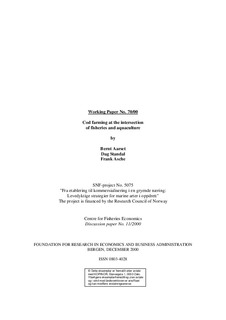| dc.description.abstract | Over the past three decades, the powerful combination of capital, research, and promising prospects has propelled salmon aquaculture to a mature, billion dollar, worldwide industry. Aquaculture entrepreneurs now search for new opportunities, but so far these attempts do not generate profit. Cod is targeted as a promising species, and here we explore the opportunities for the farming of cod. Two questions arise: (1) What characterizes cod as a farmed species? (2) How do these characteristics affect the window of possible opportunities for initiating cod-farming operations? Three pillars constitute cod as a farmed species. The market structure determines the prices through a supply/demand balance. Scientific knowledge provides species-specific biological characteristics that demand tailored technical solutions. And production systems (such as conventional coastal cod fisheries and industrial fish farming) provide preexisting institutions that govern activity. We argue that the advantage of cod as a farmed species in a starting-up phase is, firstly, the price stability provided by a market structure maintained by a large, "conventional" cod-fisheries sector. Secondly, the huge library of practical and scientific knowledge about cod and cod fisheries comprises a valuable resource. Thirdly, the general familiarity with cod as a species (among fish processors, fish buyers and exporters, in large consumer groups, and among public managers and supervisors), ensures a realistic anticipation of future problems. Lastly, the availability of cod fisheries institutions that direct focus, create attention, and organize decisions constitutes significant potential support for cod aquaculture. However, the path to a future cod-farming industry is not pre-determined. Strategic choices are continuously made that open and close further organizational options. We present and discuss models for industrial organization. | en |
